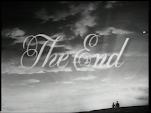Partly because I'm currently reading the fascinating Film Moments: Criticism, History, Theory, it has occurred to me that one nice ongoing project for this blog might be to occasionally point to some particularly striking critical attempts to describe cinematic moments, along with an image or two which evokes them. Sometimes I may offer my own description of these moments, at other times not. Either way, I intend the series to stand as a tribute to one of the prime tasks of the film critic - as Victor Perkins put it: "to articulate in the medium of prose some aspects of what artists have made perfectly and precisely clear in the medium of film". As any film critic knows, this process constitutes an always challenging, and often exhilarating, experience (as Girish, with the help of Stanley Cavell and Christian Keathley, begins a discussion about here).
It seems strangely fitting to begin with an instance of a critic finding that words in fact fail him when faced with a moment he especially prizes: Robin Wood, speaking of a scene from Richard Linklater's Before Sunrise (1995) in his book Sexual Politics and Narrative Film. Wood's admittance of failure here is a touchingly honest reminder of the difficulty of our endeavour when we try to put into words the ineffable.

Wood writes,
"I have to confess, at this point, to a failure: even on first viewing I told myself that I would 'one day' analyze in detail the scene in the listening booth of the record store, in which nothing happens except that Ethan Hawke and Julie Delpy either do or don't look at each other, their eyes never quite meeting. After a dozen viewings I abandoned the project. I suppose one might try an elaborate system of charts and timings, annotating 'direction of the gaze', when and how long each looks (or doesn't)... which would demonstrate nothing of the least importance. With no camera-movement, no editing, no movement within the frame except for the slight movements of the actors' heads, nothing on the soundtrack but a not-very-distinguished song that may vaguely suggest what is going on in the characters' minds and seems sometimes to motivate their 'looks' ("Though I'm not impossible to touch / I have never wanted you so much / Come here"), the shot seems to me a model of 'pure cinema' in ways Hitchcock never dreamed of (not merely 'photographs of people talking', but photographs of them not talking), precisely because it completely resists analysis, defies verbal description. All one can say is that it is the cinema's most perfect depiction, in just over one minute of 'real' time, at once concrete and intangible, of two people beginning to realize that they are falling in love."
A number of years ago I attempted my own partial account of this moment, focusing on one aspect of it in particular, in this piece comparing Linklater's movie with Minnelli's The Clock (1945). Yet neither Wood nor I have captured its essence; both despite and because of its simplicity, it remains elusive, "at once concrete and intangible".
I look forward to revisiting other instances of critics trying to do justice to their encounters with moments. The amazing thing is that, sometimes, we almost succeed.
.

No comments:
Post a Comment